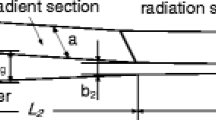Abstract
The first Ka-Band Deep Space Network downlink demonstration was recently carried out by the Ka-Band Link Experiment (KABLE) in association with the Mars Observer spacecraft. In order to support the mission, a dichroic plate was required in the DSS-13 beam waveguide antenna to allow simultaneous X- and Ka-Band dual-frequency operation. AnX/Ka/KABLE dichroic plate was designed to transmit a future Ka-Band downlink (31.8–32.3 GHz), future Ka-Band uplink (34.2–34.7 GHz), and KABLE downlink frequency (33.6–33.8 GHz), while reflecting X-band (7.1–8.6 GHz). A computer program was developed for the analysis of a dichroic plate with rectangular apertures using the mode-matching method. The plate was then fabricated and tested. The reflection, group delay, and noise temperature in the antenna system due to the dichroic plate were measured. The experimental results show good agreement with theoretical predictions.
Similar content being viewed by others
References
N. Amitay, V. Galindo, and C. P. Wu, “Theory and Analysis of Phased Array Antennas,” New York: Wiley-Interscience, 1972.
C. C. Chen, “Transmission Through a Conducting Screen Perforated Periodically with Apertures,”IEEE Trans. Microwave Theory Tech., vol. MTT-18, no. 9, pp. 627–623, September 1970.
C. C. Chen, “Transmission of Microwaves through Perforated Flat Plates of Finite Thickness,”IEEE Trans. Microwave Theory Tech., vol. MTT-21, no. 1, pp. 1–6, January 1973.
S. W. Lee, W. R. Jones, and J. J. Campbell, “Convergence of Numerical Solutions of Iris-Type Discontinuity Problems,”IEEE Trans. Microwave Theory Tech., vol. MTT-19, no. 6, pp. 528–536, June 1971.
N. Marcuvitz,The Waveguide Handbook, New York, McGraw-Hill Book Company, Inc., 1951.
R. Mittra, T. Itoh, and T. S. Li, “Analytical and Numerical Studies of the Relative Convergence Phenomenon Arising in the Solution of an Integral Equation by the Moment Method,”IEEE Trans. Microwave Theory Tech., vol. MTT-20, no. 2, pp. 96–104, February 1972.
S. W. Lee, G. Zarrillo, and C. L. Law, “Simple Formulas for Transmission Through Periodic Metal Grids or Plates,”IEEE Trans. Antenna Propagat., vol. AP-30, no. 5, pp. 904–909, September 1982.
J. C. Chen, “Analysis of a Thick Dichroic Plate with Rectangular Holes at Arbitrary Angles of Incidence,”TDA Progress Report 42-104, October–December 1990, Jet Propulsion Laboratory, Pasadena, California, February 15, 1991.
J. C. Chen, “X/Ka-Band Dichroic Plate Design and Grating Lobe Study,”TDA Progress Report 42-105, January–March 1991, Jet Propulsion Laboratory, Pasadena, California, May 15, 1991.
Author information
Authors and Affiliations
Rights and permissions
About this article
Cite this article
Chen, J.C., Stanton, P.H. & Reilly, H.F. Skew-grid dichroic plate with rectangular apertures for use on a Ka-Band beam waveguide antenna. Int J Infrared Milli Waves 14, 2401–2422 (1993). https://doi.org/10.1007/BF02086215
Received:
Issue Date:
DOI: https://doi.org/10.1007/BF02086215




